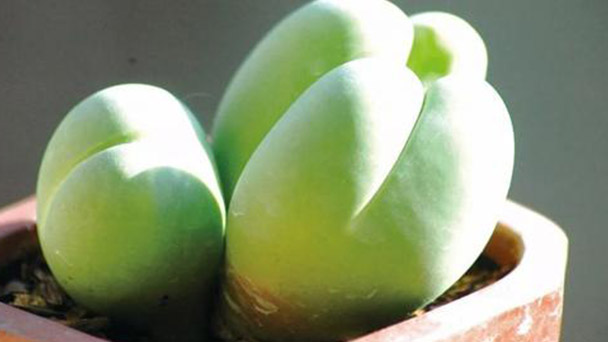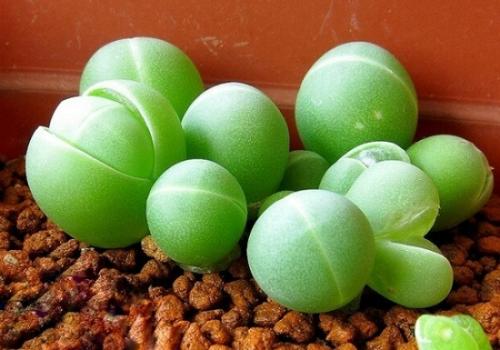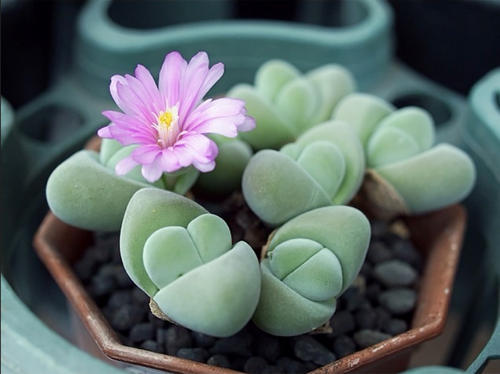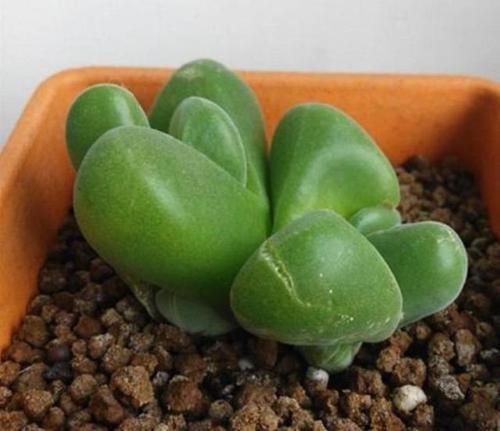Dibbosus profile
Written by Maggie
Dec 07 2020

Dibbosus is a succulents perennial herb of Alga of the family Panthera.Because its plant is low, the form is strange, simple and charming, and is deeply in the flower friend's favor, this article mainly introduces the material about Dibbosus for everybody.
Dibbosus picture

The shape of Dibbosus
Dibbosus is a succulent perennial herb with low, clumpy plants.The fascicled leaves are elliptic, with a hump at the top, and saddle-shaped notches divide the plant into unequal half unions.T leaf surface is smooth, light green, triangular at top, abaxially curved at back, slightly curved inside.Flowers are pale pink, sessile and ebracteate, 2--3 cm in diameter per plant.It looked a bit like a rabbit when it was young, but when it was older, it was heart-shaped and had only one flower for each plant.

Dibbosus' growth habits
Dibbosus is native to the Little Karoo Plateau in South Africa. It likes warm and sunny environments and is drought tolerant but not cold tolerant. It is afraid of water and can be watered several times a year.Good drainage of fertile soil, the choice of leaf soil plus garden soil plus granular soil or coarse sand and other mixed plants.The suitable temperature for growth is 18 to 24 degrees.Provide shade and ventilation during summer dormancy and reduce watering.In winter temperature requirements is of 10 degrees above In low temperature environment we need to stop watering.
Dibbosus flowers generally open in the afternoon and close at night, so that day and night remain closed for about 7 days. It is difficult to open on rainy days or in cultivation sites with insufficient light. Plants are cross-pollinated, and silver-glow-jades are easy to cluster.1 2 head off every year, if they have a large spread after peeling separately in the coming year will be fewer in number 1 1. At this time, the plant can point strains, separated from a clump of a cluster of small spread, so that the nutrition is to supply, separately will gradually to normal, but the fascicular plants good-looking, more spectacular.

Latest Updated
- Benefits of Bugleweed - 7 Science-backed Health Benefits
- Bugleweed Dangers & Side Effects - Is It Poisonous?
- How to Plant Evergreen Trees - What You Should Know
- When to Plant Evergreens - Grow Guide for Evergreen Trees
- 12 Wonderful Evergreen Shrubs for Your Garden
- 12 Popular Evergreen Plants with Pictures for Beginners
- When And How To Prune A Lilac Bush Like a Pro
- How to Grow & Care for Lilac Vine (Hardenbergia Violacea)
- Japanese Lilac Tree (Syringa Reticulata) Care & Propagation Guide
- Shumard Oak Pros and Cons - What to Know
Popular Articles
- Winter maintenance of Antirrhinum Majus
- How to Grow Terminalia Mantaly Tree
- How to Grow and Care for Crossostephium Chinense
- How to grow Antirrhinum Majus in spring
- Peristeria Elata (Dove Orchid) Profile: Info & Care Guide
- Underwatered Snake Plant (Sansevieria Trifasciata) - Signs And How To Fix
- How to Care for Brazilian Jasmine Plant (Mandevilla Sanderi)
- How to Grow & Care for Graptopetalum Purple Delight in Summer
- Rosa Chinensis (China Rose): Plant Growing & Care Tips
- How to Care for Baby Sun Rose (Aptenia Cordifolia)